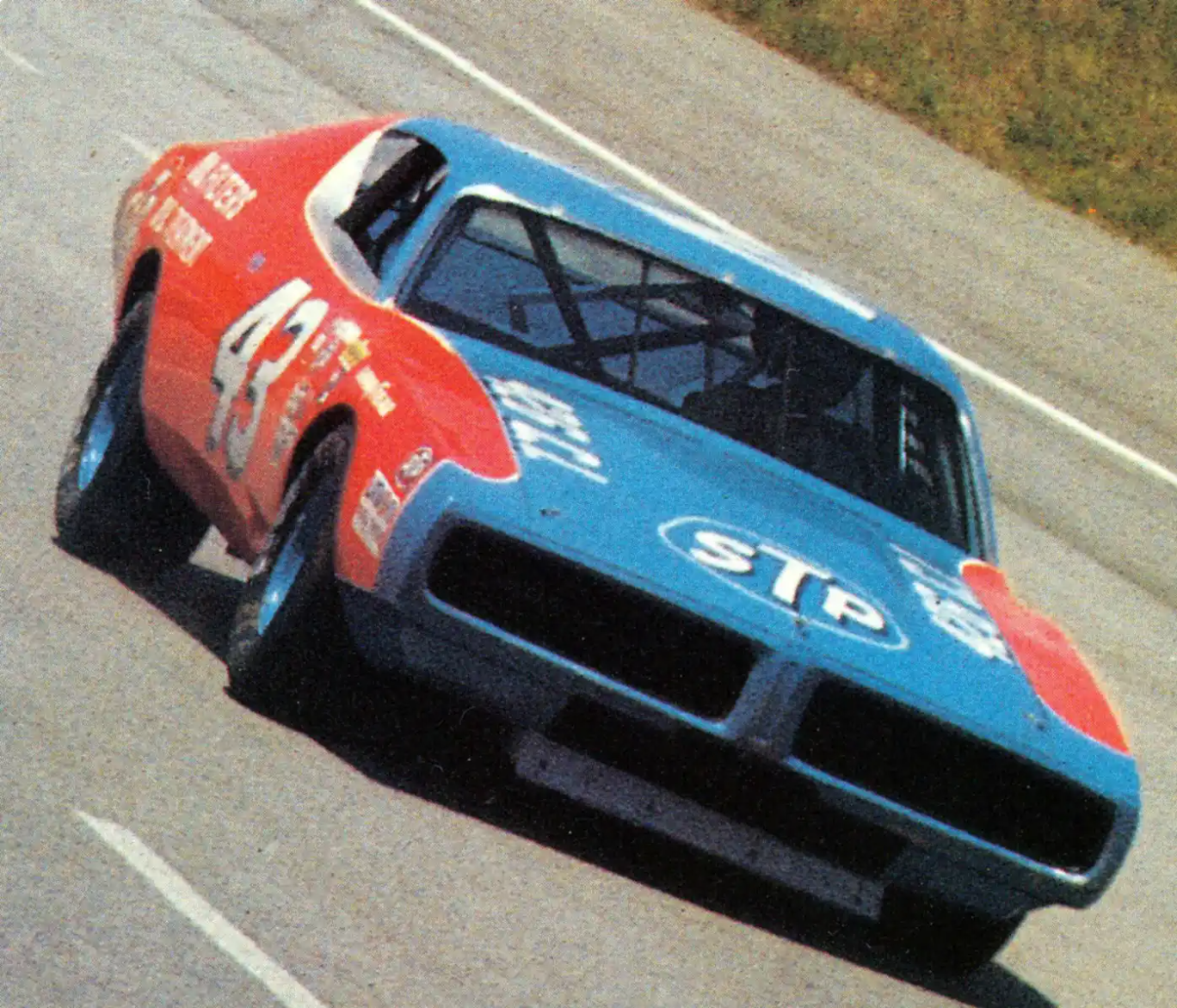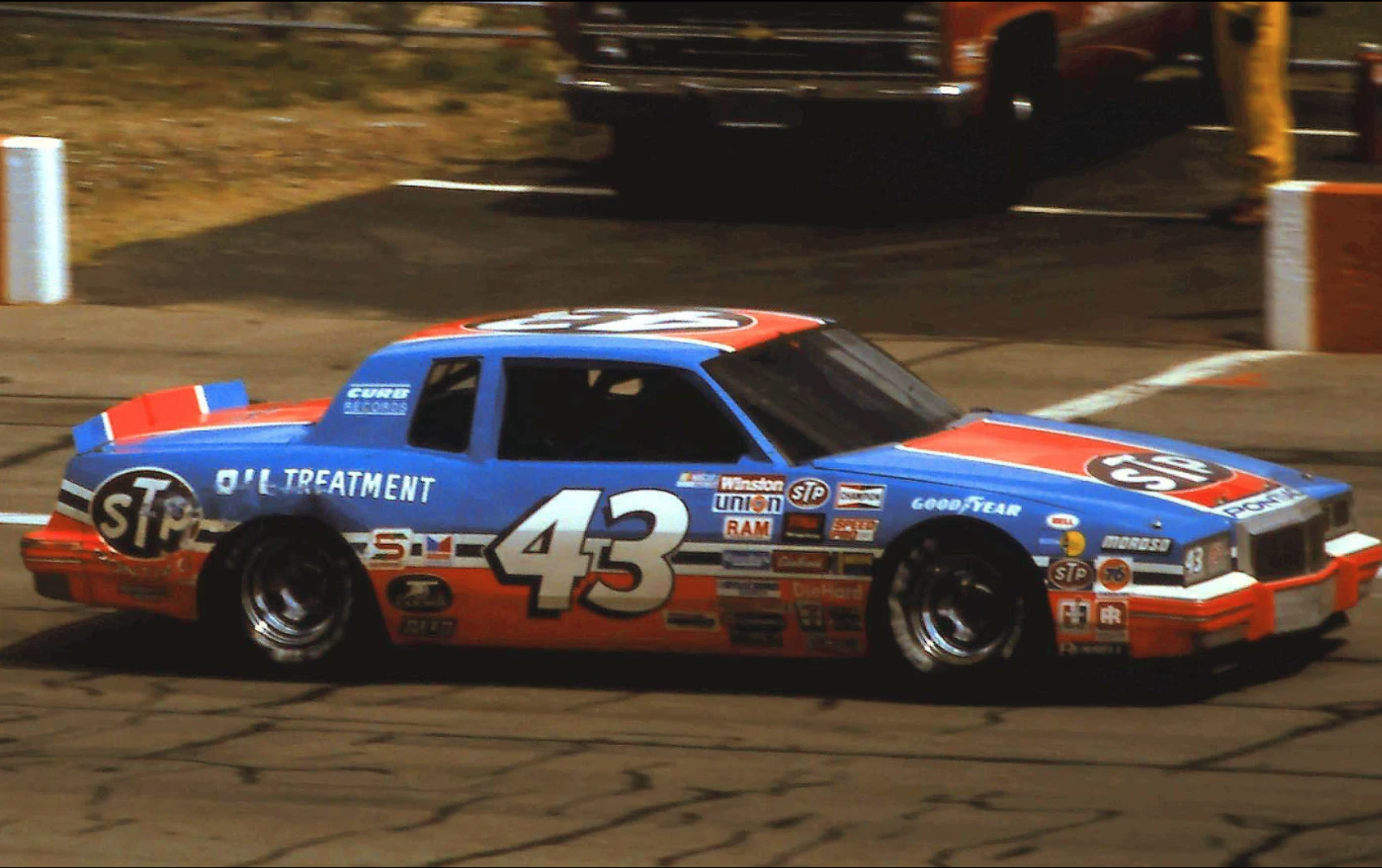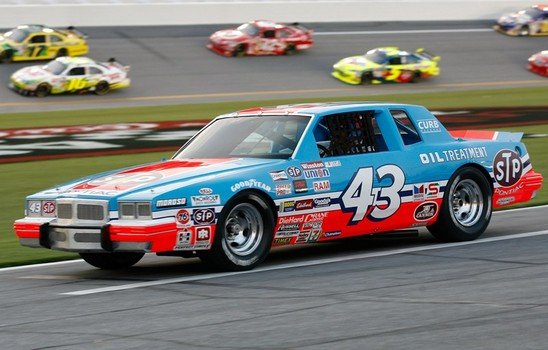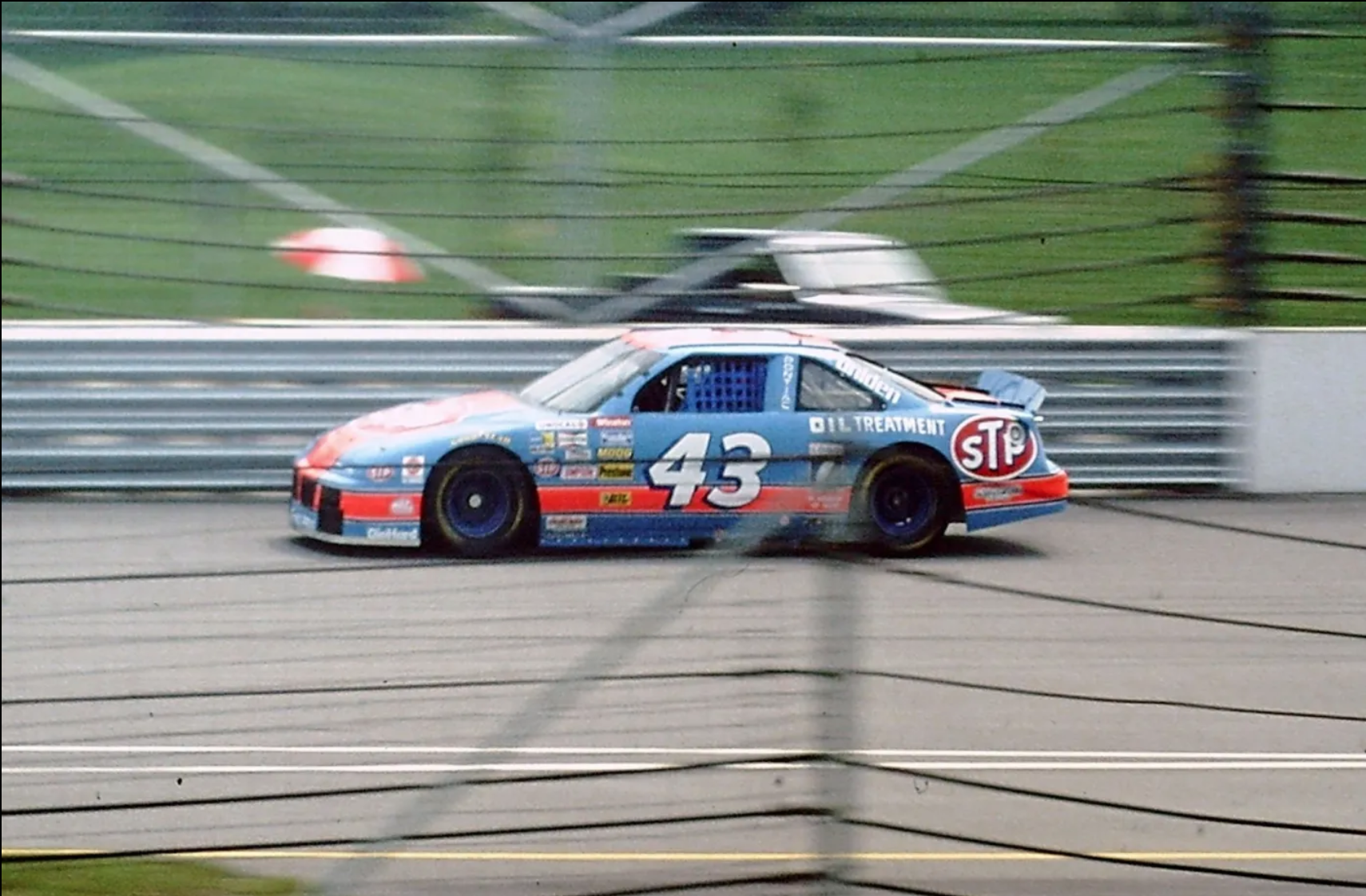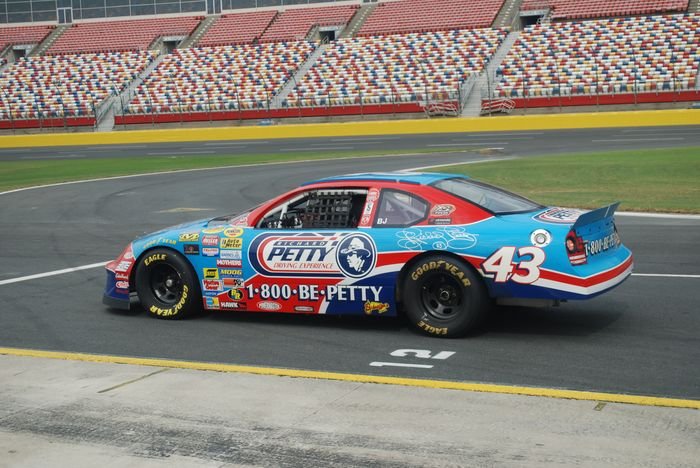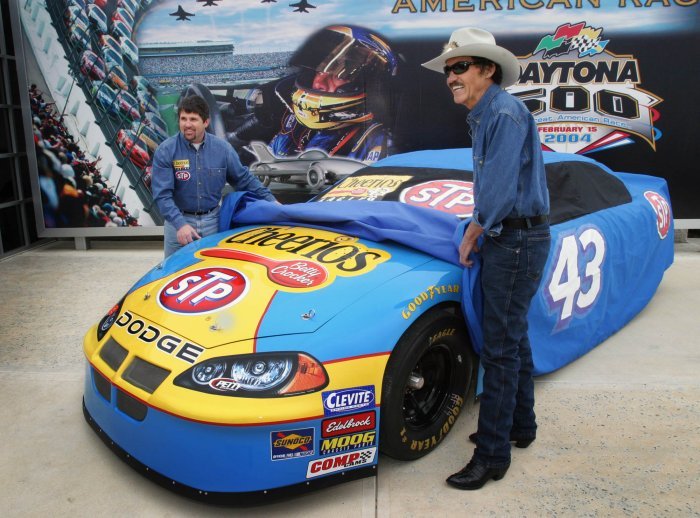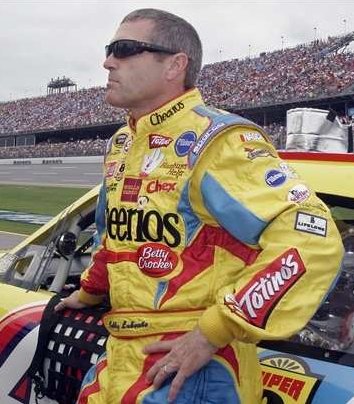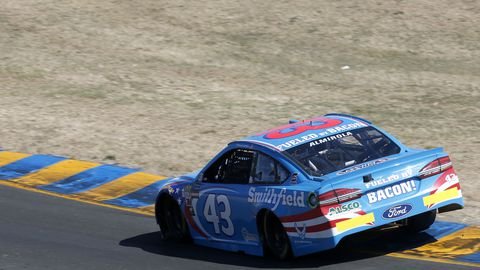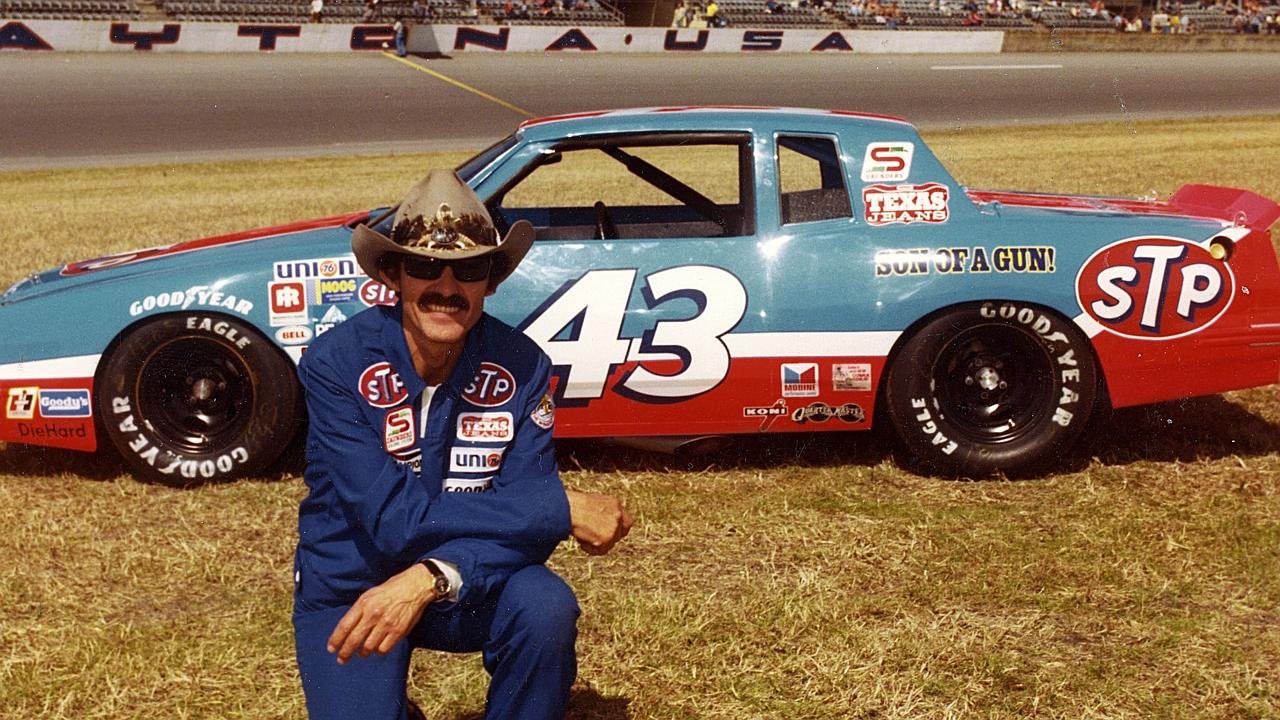
In NASCAR Cup Series competition the #43 car has started more races than any other number. The number has started 2,240 races and has 200 wins, 122 poles, 580 top 5s, and 854 top 10s.
Richard “The King” Petty has the one of longest and most successful career anyone has ever had in NASCAR. He started #43 1,125 times out of his career total 1,184 races, from his first race 16 days after his 21st birthday in Toronto, Canada in 1958 until his final start at Atlanta in 1992 Petty Earned 192 of his record 200 wins driving #43. His first career win came in 1960, but his breakout year would be 1963 winning at tracks like Martinsville and Bridgehampton. In 1964 he would capture his first Daytona 500 win and his first Grand National (Cup Series) Championship.
Joining in the Chrysler boycott of NASCAR due to the organizing body’s ban of the Hemi engine, Petty spent much of 1965 competing as a drag racer. He crashed his car at the Southeastern Dragway, in Dallas, Georgia, on February 28, 1965, killing a six-year old boy, Wayne Dye, and injuring seven others.
He returned to NASCAR in 1966 to win his second Daytona 500. Petty was 2 laps down at one point, but overcame the deficit to win the rain shortened event, on lap 198 of 200. Petty won his second championship in 1967 after dominating the season. One of the 27 victories was the Southern 500 at Darlington, which would be his only Southern 500 victory. His dominance in this season earned him the nickname “King Richard”. He had previously been known as “the Randleman Rocket”
In 1969 Petty switched brands to Ford, due to his belief the Plymouth was not competitive on super-speedways; he wanted a slippery Dodge Daytona but Chrysler executives insisted he stay with Plymouth.
He would win 10 races and finish second in points. Won back in 1970 by the sleek new Plymouth Superbird with shark nose and goalpost wing, Petty returned to Plymouth for the 1970 season. This is the car in which Petty is cast in the 2006 Pixar film Cars.
In 1972, after losing factory support from Chrysler, STP Oil Company would begin sponsoring the #43, a partnership that still exists today. STP originally wanted the car all red, but after negotiating all night Petty formed a compromise to keep the familiar “Petty Blue” on the car in some capacity. Despite a few setbacks, in the 1970’s Petty would be nearly unstoppable as he won the 1971, 1972, 1974, 1975, and 1979 Winston Cup Championships. During this time he also won the 1971, 1973, & 1979 Daytona 500s, in addition to the 1974 Daytona 450, shortened due to the energy crisis. He also almost won the 1976 Daytona 500, but after a turn 4 wreck with David Pearson he would come to rest in the grass about 100 feet from the finish line.
In 1981 Petty won his 7th and final Daytona 500, a record that still stands today. Petty struggled through the early 1980s. He shocked many people in 1984 when he left his family team of Petty Enterprises to drive for Mike Curb. On July 4, 1984 Petty won the Firecracker 400 at Daytona, his 200th and final career win. The occasion was made even more special because President Reagan attended the race.
In 1986 Richard returned to Petty Enterprises where he drove for the remainder of his driving career. At the 1988 Daytona 500 Petty was involved in a terrible crash. He walked away unharmed. In 1991 Petty announced that 1992 would be his final racing season. Petty qualified for all 29 events in 1992, finishing the season off at Atlanta. The 1992 Atlanta race is one of the most historically interesting races ever. In addition to being Petty’s last race, it was future star Jeff Gordon’s first ever race, and Alan Kulwicki would win the championship that day out of the 6 eligible drivers.
Since retirement Petty has ceremonially driven his #43 a few times, but his last laps at speed came at the Indianapolis Motor Speedway in 1993 at a test session preparing for the first ever Brickyard 400. Petty’s car was donated to the IMS Museum after the test.
Even after his driving career, Richard is still seen weekly at the race track. He still fields his #43 with Richard Petty Motorsports, and involves fans in the action with the Richard Petty Driving Experience (recently rebranded recently to the NASCAR Racing Experience, but Petty is still involved in the ownership). Petty won 7 Cup Series championships, tied with Dale Earnhardt and Jimmie Johnson for the most ever. He is alive and kicking at 85 years old.
Following Richard Petty’s retirement, the famous #43 was changed to #44 with driver Rick Wilson for the 1993 season. In 1994 Wally Dallenbach Jr. has hired to drive the car and the number was changed back to 43. Wally made 14 starts in the car before being released.
John Andretti was hired to finish out the 1994 season in Dallenbach’s place. Andretti would leave Petty Enterprises at the end of the year, but would return to drive #43 from 1998-2003. Andretti scored a win at Martinsville in 1999 driving the #43, 1 of only 2 in his career. This would also be the last win for Petty Enterprises before dissolving into RPM in 2009. John Andretti also drove #43 in 3 Indy Car Series events betweeen 2009-2010 including the 2009 Indianapolis 500. The car was fielded in a joint venture between Petty Enterprises and Andretti Autosport, the Indy Car team owned by John’s cousin Michael Andretti. John started the #43 car a total of 197 times in Cup competition. John Andretti passed away on January 30, 2020 after a long battle with colon cancer. #CheckItForAndretti
Between Andretti’s two stints with the team, Bobby Hamilton drove the #43 from 1995-1997 with 94 starts and 2 wins
Following John Andretti’s departure in the 2003 season, Christian Fittipaldi made 10 starts in the #43. Jeff Green also made some starts that year and would continue to drive the car through 2005, a total of 80 starts.
Starting in 2006 former series champion Bobby Labonte raced the #43 for 108 starts earning 3 top 5 finishes. Bobby drove the car through the 2008 season.
In 2009 Reed Sorenson drove the #43 for 36 races. Sorenson struggled all year earning only 1 top 10 finish.
After driving #44 for RPM in 2009, A.J. Allmendinger moved to the famous #43 for the 2010-2011 seasons. ‘Dinger earned 18 top 10 finishes in 2 years and 72 races before moving to Penske Racing in 2012.
Following Allmendinger’s departure to Penske, Aric Almirola was hired in 2012 to drive the #43. Almirola’s best season so far was 2014 where he earned 7 top 10s and 1 win at Daytona exactly 30 years after Richard Petty won his 200th race. This win punched Aric’s ticket into the 2014 Chase for the Sprint Cup. 2015 did not have the same outright success for the #43 team, though Almirola did earn 3 top 5 and 6 top 10 finishes while improving on his average finish compared to the previous year. 2016 seemed to be a step back for the #43 team as they earned only 1 top 10 all season. The main culprit for this regression seems to be the in-house chassis made by Richard Petty Motorsports in 2016. After the 2017, Aric surpassed John Andretti as the driver with the second most starts in car #43 with 208.
Almirola started the 2017 season as the sole driver at RPM, and finished an impressive 4th at the 2017 Daytona 500. During the Go Bowling 400 at Kansas Speedway on May 13, Almirola was involved in a violent crash along with Joey Logano and Danica Patrick. After Logano’s brake rotor exploded, he collided with Patrick, sending both straight into the wall. Almirola attempted to avoid the wreck, but instead slammed into Logano. Although he was conscious, Almirola was cut out of his car, placed onto a stretcher and airlifted to the University of Kansas Hospital where he was diagnosed with a compression fracture of his T5 vertebrae. Almirola missed 7 races while recovering, but would return to score a top-5 finish at Talladega, and a pair of 9th place finishes at Kansas and Pheonix. In September it was announced that Almirola and long-time sponsor Smithfield would not return to the 43 in 2018, and in November it was announced that both would move to car #10 at Stewart Haas Racing for the 2019 season.
During Almirola’s recovery, super-sub Regan Smith started 2 races at Charlotte and Dover, in addition to the All Star Race. Shortly after, Darrell “Bubba” Wallace Jr. was announced as the substitute drive for the remaining races, beginning at Pocono. Wallace made 4 starts with 3 top-20 finishes, including a best effort of 11th place in his final start at Kentucky. Wallace’s stay in the car was briefly interupted when road course ringer Billy Johnson made his only Cup Series start to date at Sonoma, bringing car #43 home to a 22nd place finish.
On October 25th, 2017 RPM officially announced that Bubba Wallace would pilot the #43 car full time in 2018, as the team switched to Chevrolet to explore a new technical partnership with RCR. He became the first African-American driver to have a full time Cup ride since Wendell Scott in 1971.
Wallace started the 2018 season strong by battling Denny Hamlin to the line for a 2nd place finish in the Daytona 500. It would be Wallace’s only Top 5 of the year, though he would bring home 2 more Top 10 efforts at Texas (spring) and ISM/Phoenix (fall). Wallace ended up 28th in overall points.
In 2019 Wallace returned to the #43 team, despite not having secured much sponsorship. The highlight of Wallace’s season would be a hard-fought 3rd place finish at Indianapolis, Wallace’s only top-10 of the year. Wallace would also spark controversy at the Charlotte Roval race when, following an on-track feud with Alex Bowman, Wallace angrily tossed his beverage at Bowman and the NASCAR medical staff attending to him.
When the 2020 season started, many fans were speculating that the lack of sponsorship would cause RPM to cease operations before the end of the season. Prior to the Covid-19 hiatus, Bubba showed some speed with a 15th place finish at Daytona and a 6th place finish at Las Vegas.
During the stoppage, Wallace participated in the NASCAR-sanctioned eNASCAR iRacing Pro Invitational Series, where he made headlines at the sim racing league’s Bristol event for voluntarily leaving the game early after wrecking on the 11th lap. Wallace later stated that he had wreck his digital car (he ran out of “resets”) and didn’t see any purpose in driving a damaged car around with nothing to gain. Wallace responded to fan criticism by mocking how easily they got offended over a video game. In response, his main sponsor Blue-Emu dropped its sponsorship of both the virtual and real-life No. 43 car. Blue-Emu executive vice president Ben Blessing said that Wallace’s outburst would have been unacceptable during a physical race.
When the NASCAR The Cup Series returned to the track in May, Bubba led 3 laps at Darlington and finished 10th at Bristol. Late May and June 2020 brought the topic of racial justice & equality to the forefront of American life, following the murder of George Floyd in Minneapolis, Minnesota. Bubba, being the only black driver in a predominantly white sport, spoke out about police brutality and called for NASCAR to implement a ban on the flying of the confederate flag at its events. NASCAR responded to Bubba’s requests 2 days later and banned the flag from NASCAR events. Bubba’s activism was met with criticism by many fans, but the drivers and teams mostly supported the decision to promote inclusivity in the sport. On June 10, 2020, Wallace drove a “Black Lives Matter” at Martinsville in place of the recently departed Blue Emu sponsorship. The car featured a peace sign designed by Richard Petty.
A day after the race, an investigation by the FBI concluded that Wallace was not the victim of a hate crime: the alleged noose was a pull-down rope with a loop that was located on an overhead door, and had been in the garage since the fall Talladega race in 2019. On June 25, 2020, NASCAR released a photo of the noose taken by security. In a teleconference later that day, Phelps explained NASCAR had inspected every garage at the sanctioning body’s 29 tracks, with 11 garages containing pull-down ropes tied in knots but only Wallace’s being tied into a noose.
Two weeks after the GEICO 500, on July 6, United States president Donald Trump tweeted that Wallace should apologize for the investigation, branding it a hoax while adding it and NASCAR’s Confederate flag ban “has caused lowest ratings EVER!” Trump’s ratings claim was refuted by Fox Sports executive vice president Michael Mulvihill, who said the ratings had increased by eight percent since the 2020 season resumed in May, while Wallace received support from figures like Johnson, driver Tyler Reddick, and basketball player LeBron James. Later in the day, Beats Electronics announced that it had signed Wallace to an endorsement deal, noting the company had intended to do so later in the week “but hate cannot win the day.”
Beats was the first of many companies to begin financially backing Bubba Wallace in the Summer of 2020, with Columbia Sportswear, CashApp, and Door Dash all gracing the side of Bubba’s #43 car on multiple occasions. Bubba’s influx of popularity and corporate support seemed to have erased the financial concerns that Richard Petty Motorsports was facing. Rumors began swirling that RPM would switch to Toyota and form an alliance with Joe Gibbs Racing. Eventually, it was announced that Wallace and most of his newfound sponsors would depart from RPM at the conclusion of 2020 to join 23XI Racing, a new team co-owned by Denny Hamlin and Basketball Legend Michael Jordan.
Bubba Wallace started 112 races in car #43 with 3 top-5 and 9 top-10 finishes.
Following Wallace’s tenure, Erik Jones took over the drivers seat of the legendary 43 starting in 2021. Jones scored 6 top-10 finishes in 2021.
Jones returned in 2022, as the GMS Racing team invested in RPM to create “Petty GMS Racing.” Part of this merger was the addition of car #42 with Ty Dillon behind the wheel. Jones had dramatically improved results in 2022, with 13 top 10 finish and 3 top 5s. Jones scored the 200th win for the Petty 43 car at the Southern 500 at Darlington. In 2023 Jones score only one top-5 finish at the Bristol Dirt race, as the team changed it’s name to “Legacy Motor Club.” Jones has 108 starts in #43 to date, and he will return in 2024 as Legacy Motor Club switches to Toyota.
Jim Paschal was one of the first Petty Enterprises drivers to not actually be named Petty. He drove the Petty Powered #41 & #42 in many races, and even had a few starts in #43 back in the 1960s. He started 12 races in #43 and earned 2 wins driving the number.
Richard’s father Lee Petty is best known for driving #42, but he did start #43 twice in 1959, including 1 win.
Other notable names in #43
Maurice Petty, 4 starts
Kyle Petty, 1 start
LeeRoy Yarbrough, 1 start






